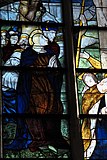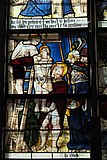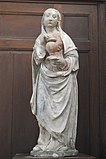Ste-Osmanne (Féricy)
The Catholic Church of Sainte-Osmanne in Féricy , a parish in the Seine-et-Marne department in the French region of Île-de-France , was built at the end of the 12th century on the site of a previous church from the 11th century. The church was expanded in the 15th and 16th centuries. Lead glass windows from the Renaissance are still preserved in the church . In 1930 the church was added to the list of architectural monuments in France as a monument historique .
history
In 1405 the church received from the former Abbey of Saint-Denis , who was under, relics of the holy Osmanna, an Irish princess who in the area of Saint-Brieuc and later near Saint-Calais in today's Sarthe department in The Pays de la Loire region is said to have lived as a recluse . The French community of Sainte-Osmane , which is named after the saint and whose church bears her patronage , is considered to be the place where she died. During the Norman invasions , her remains were taken to the former Saint-Denis abbey church, where a chapel is dedicated to her. Osmanna is often mistakenly equated with Osanna von Jouarre , an Irish princess whose bones rest in a sarcophagus in the Saint-Paul crypt in Jouarre . According to legend, when the relics of St. Osmanna arrived in Féricy, a spring appeared in front of the church. The water was said to have a fertility-promoting effect and a lively pilgrimage developed. Anna of Austria , the mother of the later Sun King Louis XIV. , And Maria Theresa , the wife of Louis XIV., Also visited the church of Féricy from the nearby royal castle Fontainebleau in the hope of the early birth of a long-awaited heir to the throne.
architecture
Exterior construction
The three-bay ship dates back to the 12th century. The transept, the just closed choir and the side chapels were built in the 15th and 16th centuries. The portal on the west facade, created in the 16th century, is framed by columns on high plinths and a triangular gable. A sawtooth are on the south side under the umbrella approach fragments frieze to recognize that originate from the 12th century. Also on the south side is a niche with a Renaissance decor cut into the outer wall. The bell tower originally built over the narthex was demolished in 1845 and two years later a new bell tower was placed in front of the choir head.
inner space
A vestibule connects to the west portal. The three bays of the ship have ribbed vaults that on the north side on consoles and on the south side of buds capitals lie. The south aisle consists of three chapels.
Leaded glass window
In the choir and transept, leaded glass windows have been preserved, which were made in a Paris workshop between 1532 and 1540.
Window 0: Crucifixion of Christ
The central choir window depicts the crucifixion of Christ . The two thieves are depicted to the right and left of Jesus. Under the cross are Longinus , who is stabbing Jesus in the side with a spear, and Stephaton , who is holding the vinegar-soaked sponge in front of Jesus' mouth. On the left lancet you can see the apostle John , on the right two elegantly dressed men on horseback. At the foot of the cross stand Mary and Mary Magdalene , who holds the cross with her arms. In tracery angels are shown.
Window 1: Legend of St. Osmanna
The legend of St. Osmanna is depicted on the northern choir window. There is an inscription under each scene. Osmanna, who was converted to Christianity, refuses to worship her parents' pagan idols. She leaves Ireland in a boat accompanied by her servant, St. Cérotte. They land in Saint-Brieuc in Brittany and find refuge in the forest. There they rescue a wild boar that is pursued by hunters and that the hunters' lances cannot kill. When the Bishop of Saint-Brieuc found out about this miracle, he gave the two women a small chapel and gave them a gardener at their service. After a few years the devil seduces the gardener into improper behavior towards Saint Osmanna, whereupon the gardener is struck with blindness and falls into madness. With her second miracle, Osmanna saves a young girl who had a bone stuck in her throat from suffocating. In the last scene, Osmanna ensures that a mute young prince can speak again. According to another version, she gives him back his eyesight. The year 1534 can be read in the lower right pane.
Window 2: Noli me tangere and chicken miracles
The southern choir window is composed of panes from two different windows. The upper part depicts Jesus, who appears as a gardener to Mary Magdalene after his resurrection ( Noli me tangere ). The lower part shows episodes of the chicken miracle . A son goes on a pilgrimage to Santiago de Compostela with his parents . You will spend the night in a hostel in Santo Domingo de la Calzada . The maid of the house falls in love with her son, who rejects her. In revenge, she hides a silver mug in her son's luggage and accuses him of theft. The son is sentenced to death and hanged. On their return from the pilgrimage, the parents find their son alive on the gallows. They ask the judge to overturn the sentence because their son is miraculously still alive. The judge replies to the parents that their son is as alive as the chickens on his plate, whereupon the chickens start to flutter. These scenes are also provided with inscriptions.
Window 3: Adoration of the Shepherds, Adoration of the Magi
The window in the north transept shows the Adoration of the Shepherds in the upper part and the Adoration of the Magi in the lower part . Mary is depicted on the upper disc of the left lancet, on the middle disc Christ is symbolized by the Lamb of God and on the lower disc the inscription "ECCE AGNUS DEI" (this is the Lamb of God) can be read. In the tracery you can see a dog in the middle watching over grazing sheep.
Window 4: Donors
Etienne Clément and his wife Louise with their children and their patron saints, Saint Stephen and the French King Louis the Saint , are depicted on the donor window in the south transept . Etienne Clément was the owner of the Domaine de la Salle in Féricy from 1534 to 1542. The panes depicting the donors originally belonged to the chicken wonder window. In the tracery of the founder window you can see the pilgrims praying with their son to the apostle James .
Sculptures
- The stone figure of St. Osmanna is dated to the late 14th or early 15th century. It was revised in the 19th century.
- The colored stone sculpture, which holds an ointment vessel as an attribute , probably represents Maria Magdalena . It was created in the 16th century.
- The female figure depicted with a dragon, which can be interpreted as Saint Martha or Saint Margaret , also dates from the same period .
Holy water font
The stone holy water font from the 12th century is carved on the edge with human faces.
literature
- Louis Grodecki, Françoise Perrot, Jean Taralon (eds.): Les vitraux de Paris, de la région parisienne, de la Picardie et du Nord-Pas-de-Calais . (= Corpus Vitrearum Medii Aevi ). Récensement des vitraux anciens de la France. Volume 1, Éditions du Center National de la Recherche Scientifique, Paris 1978, ISBN 2-222-02263-0 , pp. 98-99.
- Georges Poisson (ed.): Dictionnaire des Monuments d'Île-de-France . Éditions Hervas, Paris 2001, ISBN 2-84334-002-0 , p. 326.
- Le Patrimoine des Communes de la Seine-et-Marne . Flohic Éditions, Volume 1, Paris 2001, ISBN 2-84234-100-7 , pp. 242-243.
- Jacques Baudoin: Grand livre des saints: Culte et iconographie en Occident . Éditions Créer, Nonette 2006, ISBN 978-2-84819-041-9 , p. 381.
Web links
- L'église Sainte Osmanne . Mairie de Féricy
- La Légende de sainte Osmanne, Le Pèlerinage de Saint-Jacques-de-Compostelle in the Base Palissy of the French Ministry of Culture (French)
- L'Adoration des Mages, L'Adoration des bergers, Le Chien gardant les moutons in the base Palissy of the French Ministry of Culture (French)
- Donateurs aux pieds de leurs saints patrons in the Base Palissy of the French Ministry of Culture (French)
- Gabriel Leroy: La légende de sainte Osmanne, d'après un ancien vitrail de l'église de Féricy-en-Brie (Seine-et-Marne) . Paris 1872 gallica.bnf.fr
Individual evidence
- ↑ Église Sainte-Osmanne in the Base Mérimée of the French Ministry of Culture (French)
- ↑ Joachim Schäfer: Osmanna Jouarre Ecumenical Holy lexicon
- ↑ Saintes Osmane et Osanne
- ^ Gabriel Leroy: La légende de sainte Osmanne, d'après un ancien vitrail de l'église de Féricy-en-Brie (Seine-et-Marne) . Paris 1872, p. 11. gallica.bnf.fr
- ↑ Sainte Osmanne in the Base Palissy of the French Ministry of Culture (French)
- ↑ Sainte Madeleine? in the Base Palissy of the French Ministry of Culture (French)
- ↑ Sainte Marthe ou Sainte Marguerite in the Base Palissy of the French Ministry of Culture (French)
- ↑ Bénitier in Base Palissy of the French Ministry of Culture (French)
Coordinates: 48 ° 27 ′ 35.3 " N , 2 ° 48 ′ 0.4" E
























